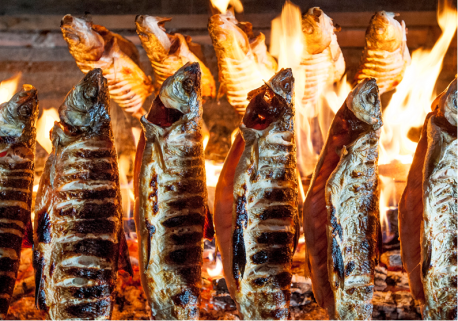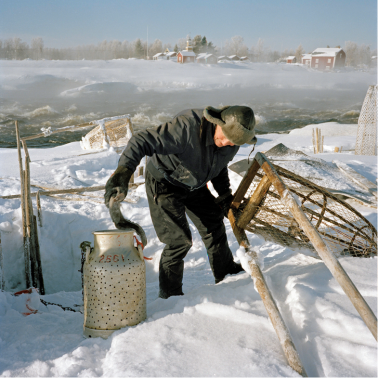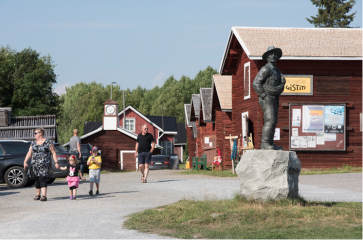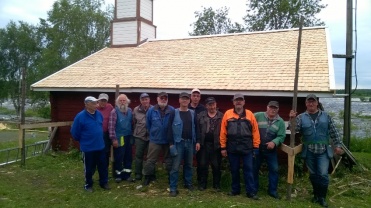Traditional fishing culture in the Torne River’s rapids
| Traditional fishing culture in the Torne River’s rapids | ||||
|---|---|---|---|---|
| In the national inventory | ||||
|

Practitioners and people who know the tradition well
Dipnet fishing is one of the most significant traditional fishing methods used along the Torne River. It is practiced by the owners of dipnet fishing rights, who form a fishing cooperative. These fishing rights have been established between the 16th and 18th centuries. The cooperative’s role is to organize fishing on behalf of its members, manage fish stocks, and preserve the tradition. Each rapid along the river has its own cooperative on both sides of the river, which serves as the national border. Fishing is conducted within the framework of the Border River Agreement. Associations organize dipnet fishing at Kukkolankoski and Matkakoski. In addition, private fishing sites along the riverbanks, such as at Vuennonkoski and other suitable rapids, are used for dipnet fishing.
The traditional rights to fish on the river extend a long way back. The owners of the properties of the special interest community in Kukkola village (houses 1–16), Tornio, were granted exclusive fishing rights in Kukkolankoski by the King of Sweden in the 18th century and form the fishing association called Kukkolankosken osakaskunta, Shareholders’ association. Meanwhile, the Korpikylän osakaskunta, Shareholders’ association which has 151 shareholders, includes ancient fishing rights for dipnet fishing for tax parcels 1-17, some of which are centuries old. Fishing rights have been passed down through generations, either by inheritance or land transactions. At Kukkolankoski, there are approximately 200–300 fishing association shareholders, with around 60 actively practicing dipnet fishing. At Matkakoski, there are about 150 shareholders, of whom a few dozen are active fishers.
The Torne River is the border river between Finland and Sweden and it is the largest free-flowing watercourse in Northern Europe. It is about 520 km long, with a discharge of 370 m³/s. The Torne River is also the most important spawning river for salmon and migratory whitefish in the Baltic Sea region. In addition to salmon and whitefish, the river hosts around 20 other fish species. The migratory whitefish and salmon populations are unique in the world, as they migrate from the saline sea to freshwater to spawn. Today, the Torne Valley region along the river has a total population of approximately 80,000 people in both Sweden and Finland. The settlement patterns along the Torne River are closely tied to fishing and hunting cultures. Even today, the fishing culture shares common features on both sides of the border, although cooperative-specific variations have developed over time. At the largest fishing site, Kukkolankoski, the fishing culture remains closest to its original centuries-old tradition.
The fishing associations are an integral part of the village communities and are represented by local village associations. The associations support community activities and collaborate to organise events such as whitefish festivals and local markets.
ProSiika ry is an association founded in 2010 that works to protect migratory fish, particularly whitefish, promotes the sustainable use of the fisheries, maintains habitats, and preserves and promotes traditional fishing. Its key task is to ensure that whitefish stocks are utilized in an ecologically, economically, and culturally sustainable manner. The association collaborates with fishers, researchers, authorities, and other stakeholders to achieve its goals and is involved in the development of related projects.
The association’s members come from various villages on both sides of the river as well as from the coastal region. In 2015, ProSiika ry was awarded the Environmental Prize by the Lapland Cultural Foundation. Several organizations and communities have supported ProSiika ry’s efforts to safeguard the tradition, including the EU, the Regional Council of Lapland, the City of Tornio, the Border River Commission, The Museum of Torne Valley, the Lapland Cultural Foundation, the Natural Resources Institute Finland, the Municipality of Ylitornio, the Rural Culture Association, Lapland University of Applied Sciences, Meän Kukkola ry (entrepreneurs), and corresponding Swedish organisations and communities.
Practising of the tradition

According to centuries-old traditions, the fishing culture in the southern Torne River Valley includes dipnet fishing for whitefish and salmon in the summer, lamprey fishing in the autumn, and burbot fishing in the winter. Traditional fishing is carried out by members of local fishing associations, whose fishing rights date back as far as the 16th century. These members have also included village residents who are not official fishing association shareholders in the practice of traditional fishing. The association organizes the fishing on behalf of its members within the framework of the Border River Agreement. The organization of fishing follows centuries-old principles, determined by each cooperative individually.
The Torne River dipnet is a relic from the Middle Ages, dating back to the 13th and 14th centuries, and is still in use today. The dipnet was developed to meet the needs of fishers and hunters along the Torne River. Dipnet fishing may have existed even earlier, but the current dipnetting tradition can be traced at least that far back. The design of the dipnet has largely remained unchanged over the centuries. Historically, dipnets were also used along other rivers, but continuous dipnetting traditions, including methods of catch distribution, have persisted particularly along the Torne River. The villages along the river have interacted with one another and originally used the same type of dipnet.
A dipnet is a scoop-like fishing device with a long handle (about 6 m), a hoop (approximately 60 cm in diameter), and a net with a mesh size of 20–40 mm. The dipnet is moved downstream in the water to catch fish resting in deep river pockets. The fisher must have knowledge of the currents and the riverbed structure. Catching fish requires skill, good equipment, and some luck. However, fish have a good chance of escaping a small dipnet in a strong current.
A dipnet consists of a handle, a hoop, a fork (or prongs), and a net. Making dipnets is a skilled craft, starting with net weaving. Dipnet makers consider the optimal structure and how different materials will behave in the water. The dipnet must be built to be as inconspicuous as possible while also being strong and appropriately sized for catching fish. In the past, only natural materials were used, whereas today, the net is woven from nylon thread or fine wire.
Piers used for traditional fishing represent a historic riverbank construction tradition. The first known piers were introduced in the Torne River in the 16th and early 17th century. Large dams are no longer built, but the building techniques survive today in the structures which are used for dipnet fishing. The manual construction of the piers requires expertise and knowledge of the river currents. These techniques, developed in harmony with nature, reflect the lives of the people who developed them. The seemingly complex structures were built entirely from natural materials, with each part serving a specific function.
Dipnetting is conducted from the riverbanks, from wooden piers, or from boats. Each dipnetting spot has its own name. Piers are platforms that provide access to the fishing spots. Due to fluctuations in water levels, current pressure and vibration, and seasonal changes, these structures sometimes need to be rebuilt or dismantled even during the fishing season. The construction of piers, bridges, and weirs is still carried out by fishers as communal work, following the damming construction techniques dating back to the 16th century.
The organization of dipnetting varies by cooperative and location. At Kukkolankoski, fishing is arranged in two different ways, depending on the catch volume. In early summer, during salmon fishing and when whitefish numbers are low, the practice is called "halmelippous," where fishing is freely conducted among the members. During this period, new dipnetters can practice, and non-fishing association shareholders can also participate in dipnetting with the association’s permission. When the whitefish numbers increase in late July and August, a 24/7 shift system is implemented. In this system, fishing shifts and the catch are divided among the fishing association shareholders according to the size of their shareholdings, known as “mantal”.

In the village of Kukkola, the houses are divided into two categories based on dipnetting days: those of high-tax and low-tax households. The distribution of the catch still takes place every evening at the same time on the rapids field, bringing together villagers and visitors alike. First, the dipnetter receives their share of fish for personal use and meals. The fishers from households on duty receive their “salary whitefish”. The remaining catch is distributed among the houses according to their shares in a traditional numerical system. In this system, fish of similar sizes are allocated into piles for the shareholder houses, which are then assigned to their owners by lottery. This method ensures that each shareholder receives a weight of fish proportional to their mantal (landholding share), maintaining an equitable distribution among all. The numerical system makes the process fair and easy to carry out in practice without the need for a scale. Three different fish allocation methods are used, all passed down from generation to generation.
The fish distribution tradition, along with other dipnetting customs, continues to reflect the traditional way of life along the rapids of the Torne River. The allocation has long been based on mantal shares, meaning that the amount of fish received by a household depends on the size of its estate. The early standardization of this system is evident in the fact that estates established after 1773 were generally no longer included in the fish distribution.
The traditional landscapes surrounding the rapids consist of structures and buildings designed for fishing activities. These structures have historically served and continue to serve as needed for accommodation, cooking, and storage of fish and fishing equipment. At Kukkolankoski, the shared buildings include the "kalapuohi" for fish storage, the "paistokota" for cooking and overnight stays, and storage sheds for fishing gear and supplies.
Living fishing traditions also include a strong culinary culture. Traditional dishes include skewered whitefish, whitefish soup, whitefish roe, and salted whitefish. Freshly salted whitefish remains a delicacy enjoyed by many today. The grilling hut is particularly well-suited for preparing skewered whitefish and whitefish soup.
Using a skewer to prepare fish is an ancient technique. Skewers have been used not only for roasting but also for smoking and drying fish for preservation. However, roasting whitefish over an open flame in the Kukkolankoski tradition is intended for immediate consumption rather than storage. The roasting of skewered whitefish is a distinct tradition of Kukkolankoski on the Finnish side and Kukkolaforsen on the Swedish side of the river. The introduction of salt in the 13th century enabled year-round fish preservation and trade, giving rise to the tradition of salted whitefish that continues today.
Traditional fishing and fish-based cuisine have historically been important sources of income and sustenance for village communities. The so-called "porina"—casual small talk about fishing—provides a natural foundation for social interaction. The fishing community’s social life also includes traditional events, such as the whitefish festival held in late July to celebrate the annual whitefish run.
Fish festivals, which are part of the customs of fishing communities, are among the oldest known festival traditions in Finland. They have been organized for centuries both along running waters and in coastal regions. Although there are no documented records of the exact dates when the first fish festivals were held in Finland, it is clear that fishing-related celebrations and markets have been an integral part of Finnish culture for centuries, including during Swedish and Russian rule. At Kukkolankoski, the whitefish festival is a long-standing tradition celebrating the whitefish run and remains a part of living cultural heritage. Roasting skewered whitefish is an essential part of the festival tradition, where people gather to eat whitefish, most often prepared on a skewer.
The background and history of the tradition
From an ethnographic perspective, dipnetting is one of the oldest fishing methods. It relies on knowledge of fish resting spots and migration patterns. Fishers have been highly familiar with their rapids, continually seeking new dipnetting locations while some of the oldest sites have remained in use for a very long time.
The permanent settlement of the Torne River Valley and the foundation of Finnish-speaking culture emerged during the early Middle Ages, primarily with settlers arriving from the Satakunta and Häme regions. Cultural connections have been identified between Satakunta and Länsipohja, including the presence of similar dipnet types which are characteristic to both areas.
The region’s fishing culture has also been influenced by the national border drawn along the river. In Kukkola, for instance, dipnetting shifts were historically synchronized on both riverbanks, with the change of shifts occurring simultaneously in the evening throughout the entire shared dipnetting period. Despite the presence of the national border in the river, Kukkola and Matkakoski followed the same local time on both sides well into the 19th century.

The Torne River dipnet is a relic from the Middle Ages, dating back to the 13th and 14th centuries, and is still in use today. The dipnet was developed to meet the needs of fishers and hunters along the Torne River. Dipnet fishing may have existed even earlier, but the current dipnetting tradition can be traced at least that far back. The design of the dipnet has largely remained unchanged over the centuries. Historically, dipnets were also used along other rivers, but continuous dipnetting traditions, including methods of catch distribution, have persisted particularly along the Torne River. The villages along the river have interacted with one another and originally used the same type of dipnet.
Piers used for traditional fishing represent a historic riverbank construction tradition. The first known piers were introduced in the Torne River in the 16th and early 17th century. Large dams are no longer built, but the building techniques survive today in the structures which are used for dipnet fishing. The manual construction of the piers requires expertise and knowledge of the river currents. These techniques, developed in harmony with nature, reflect the lives of the people who developed them. The seemingly complex structures were built entirely from natural materials, with each part serving a specific function.
Fish festivals, which are part of the customs of fishing communities, are among the oldest known festival traditions in Finland. They have been organized for centuries both along running waters and in coastal regions. Although there are no documented records of the exact dates when the first fish festivals were held in Finland, it is clear that fishing-related celebrations and markets have been an integral part of Finnish culture for centuries, including during Swedish and Russian rule. At Kukkolankoski, the whitefish festival is a long-standing tradition celebrating the whitefish run and remains a part of living cultural heritage. Roasting skewered whitefish is an essential part of the festival tradition, where people gather to eat whitefish, most often prepared on a skewer.
The transmission of the tradition
The fishing association shareholder farms have had, and still have, the responsibility to provide a dipnetter during the rotation system. Primarily, the dipnetter still comes from the household currently in turn, ensuring that dipnetting skills are naturally passed down from older generations to younger ones. Training mainly takes place in early summer during the halme-dipnetting period. The making of a dipnet, still done by hand, happens at home and is also practiced collectively in organized dipnet-making courses. Instructions for dipnet making have also been documented in digital form.

The construction of piers, using traditional dam-building techniques, is carried out today through communal work, with dozens of fishers and villagers participating. Dipnetting sites and piers are also digitally documented. The organization of voluntary work, as well as the maintenance, construction, and dismantling of fishing structures, takes place annually, with both men and women of all ages participating. The traditional method of distributing whitefish is also passed down to future generations through hands-on practice.
Culinary traditions are preserved by the fishing association shareholders and tourism businesses. Private tradition bearers and members of associations prepare traditional dishes for their families, celebrations, and other events. Tourism companies, restaurants, and hotels offer food made from local fish using traditional recipes while also developing new recipes and flavour combinations. One of the newer preparation methods in the region is making whitefish and salmon ceviche, which is based on a Peruvian traditional recipe and was included in UNESCO’s Representative List of Intangible Cultural Heritage in 2023.
In the summer of 2016, dipnet fishers from both sides of the border jointly unveiled the Dipnet Fisher Statue at the rapids field of Kukkolaforsen. The statue stands on the Swedish side of the river and highlights the significance of the dipnetting culture in the region. The shared event was also meant to emphasize the common cultural heritage of the villages on both sides of the national border.
Several projects have been carried out to maintain and promote traditions: A Village by the Rapids (2003–2006), IsoSiika (2013, in cooperation with the Rural Cultural Association), Torne Valley Summer Whitefish (2016–2018), Catch, Roast, and Enjoy Your Own Skewered Whitefish (2018), Meänmaa matkalla maailmalle (2019), and Kuas Sitte Jos Emmä Met Itte (2019–2020). In the autumn of 2020, the Merta näkyviin – talvikalauden kalastusperinne talteen -project was launched, followed by Kläpit Lipolle (2023–2025) and Torne Valley Dipnet Culture (2024–2027). These projects have included and continue to include school collaborations, youth camps, documentation of traditions using modern methods, as well as event organization, cross-border cooperation, and awareness-raising about traditional fishing. Some ongoing projects also include the development of exhibitions for both a fishing museum and a mobile museum built inside a vehicle, as well as support for nature, food, and heritage tourism, the launching of a website, and much more.
Members of the village community have also created photographic works, books, and a documentary film about Kukkolankoski. Books on culinary traditions have been published on both sides of the border.
The future of the tradition
Research on whitefish populations is currently being conducted by institutions such as the Natural Resources Institute Finland (LUKE), the Universities of Helsinki, Uppsala, and Lund, the Finnish Federation for Recreational Fishing, and the Swedish Environmental Protection Agency. Additionally, organizations such as ProSiika ry and the Tornio-Muonio River Association support this research. However, further studies on migratory fish behavior are still needed, particularly regarding the impacts of climate change and offshore wind power on migration routes and possible changes in fish movements. Ensuring that migratory fish can continue to reach their spawning grounds in the Torne River remains a key priority.
It is expected that research and various projects will provide means to support a sustainable whitefish population. The region has active and dedicated shareholder fishing communities that organize fishing activities and preserve traditions. New, enthusiastic dipnetters have joined the community. Interest in nature-based tourism, sustainable development, and local food is growing among both consumers and entrepreneurs. The appreciation of whitefish has already increased due to trends in nature tourism and local food, and global recipes using local ingredients create new culinary experiences. These projects have also strengthened collaboration between fishing communities and other stakeholders.
In 2019, the Meänmaa matkalla maailmalle project conducted a comprehensive study on the status of the protection of the Torne River rapid fishing culture and the possibilities of applying for inclusion in UNESCO’s Representative List of Intangible Cultural Heritage in the future. As part of this project, stakeholders explored other cultural traditions that had already been listed or were being applied for. Tradition bearers, staff from the Museum of Torne Valley, and representatives from the municipalities of Tornio and Haparanda have visited, for example Oostduinkerke, in Belgium, in 2019 to learn about horseback shrimp fishing (listed in 2013) and again in 2025, including a visit to Brussels to explore Belgium’s traditional irrigation system (listed in 2023) and Belgian beer culture (listed in 2016). There has been a lot of cooperation with the Kaustinen fiddle-playing tradition (listed in 2021) through mutual visits, such as in 2019 when Torne River dipnet fishers practiced dipnetting in Kaustinen, and Kaustinen folk musicians performed by the rapids at Kukkolankoski and Kukkolaforsen. In 2024, a delegation involved in the UNESCO application process visited Kaustinen to learn about the nomination process, the development of a protection strategy, and the significance of UNESCO recognition for the local community. Lessons from these experiences have been applied to the safeguarding of dipnetting culture.
Between 2023 and 2025, the Museum of the Torne Valley has coordinated the compilation of the UNESCO application in collaboration with the UNESCO-Gruppen, a group of tradition bearers representing dipnet fishing sites from both Finland and Sweden. The application for the UNESCO Representative List of Intangible Cultural Heritage of Humanity, Torne River Dipnet Fishing – Living heritage across the Swedish-Finnish border, will be submitted to UNESCO in March 2025. A decision is expected in December 2026.
The application is supported by the EU-funded Torne Valley Dipnet Culture (TVDC) project, which also focuses on raising awareness of the tradition, organizing exhibitions for both local and wider audiences, mapping the built cultural environment of the rapids areas, and drafting a cultural heritage protection strategy for 2030.
The communities behind this submission
ProSiika (NGO)
Kukkola Village Association (NGO)
Kukkolankoski Shareholders' association
Kukkolankoski website Kukkolankoski Facebook Kukkolankoski Instagram
Korpikylä Shareholders' association
Meän Kukkola (NGO)
Torne Valley Dipnet Culture project Project on LinkedIn
Bibliography and links to external sources of information
Unesco-application process 2024-2026
Fishing Museum in Kukkolaforsen (Haparanda)
Whitefish dipnet fishing in Kukkolaforsen
Meänmaa matkalla maailmalle – statement of the dipnet fishing 2019
Summer Whitefish in Torne Valley -project
"Kukkolankoski - Village protected by the fish" - documentary, premiere 24.2.2021
Insitutet för språk och folkminnen: Håvfisketraditionen i Tornedalen
More articles in the wiki-inventory (in Finnish)
Krenkkujen rakennus ja purku Tornionjoella (Building and dismantling piers in Torne River)
Lipon tekeminen (Making of dipnet)
Lippoaminen (Dipnetting)
Siianjakaminen (Distribution of whitefish catch)
Varrassiian paistaminen (Skewering whitefish)

